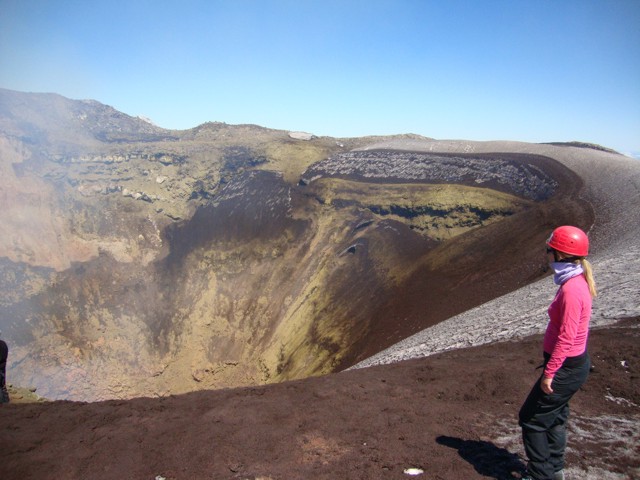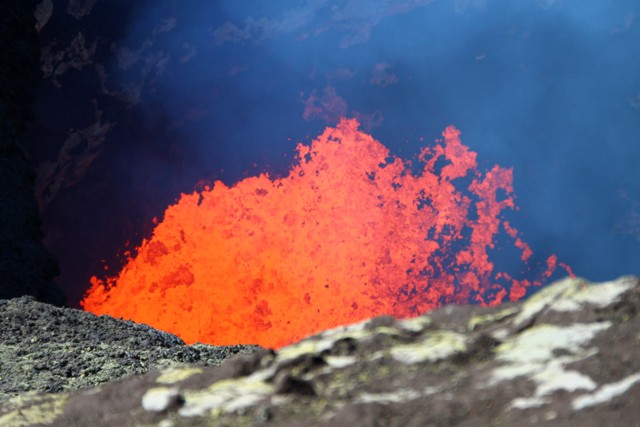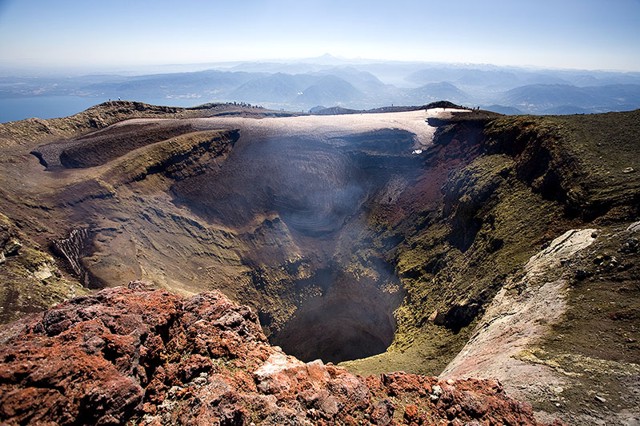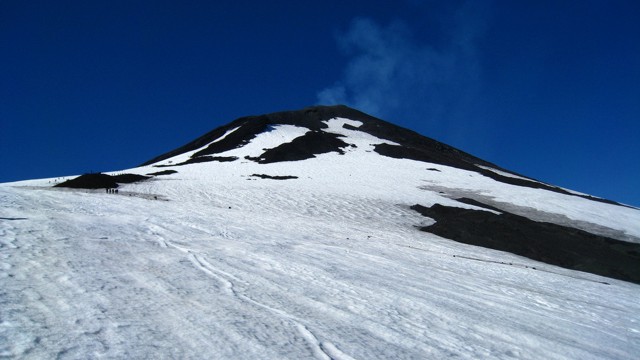Report on Villarrica (Chile) — April 2010
Bulletin of the Global Volcanism Network, vol. 35, no. 4 (April 2010)
Managing Editor: Edward Venzke.
Research and preparation by Paul Berger.
Villarrica (Chile) Lava lake in summit crater very active beginning in April 2010
Please cite this report as:
Global Volcanism Program, 2010. Report on Villarrica (Chile) (Venzke, E., ed.). Bulletin of the Global Volcanism Network, 35:4. Smithsonian Institution. https://doi.org/10.5479/si.GVP.BGVN201004-357120
Villarrica
Chile
39.42°S, 71.93°W; summit elev. 2847 m
All times are local (unless otherwise noted)
Villarrica has been relatively quiet since 4 September 2006. However, there were reports of minor activity, with occasional ash plumes and thermal anomalies through 10 February 2009 (BGVN 34:01). According to the Observatorio Volcanológico de los Andes (OVDAS-SERNAGEOMIN), during February 2009 through February 2010, the volcano experienced frequent tremor and occasional long-period earthquakes, with infrequent tectonic and hybrid earthquakes. Persistent Strombolian activity, with frequent detection of thermal anomalies, began in April 2010.
Photographs and video posted on the Projecto Observación Visual Volcán Villarrica (POVI) website demonstrate weak fumarolic activity during January-March, September, and December 2009. Climbers also documented diffuse gas plumes rising from the crater in early 2009 (figures 22 and 23). Fumaroles may have been active during other months as well; according to POVI, such emissions are a recurrent phenomenon at Villarrica, especially during times of thaw. The POVI photos and captions specifically noted that there was a phreatomagmatic explosion on 29 January. A small ash plume seen on 19 March was due to small collapses within the crater. A pyroclastic flow deposit was photographed on the upper NE flank on 22 November. Observations during an overflight on 11 December showed bombs and ashfall near the crater rim.
Visitors in January 2010 recorded similar degassing conditions (figure 24) as that often seen in 2009. According to a January 2010 report by OVDAS, the only part of the crater that showed signs of heat without the presence of fresh snow was a fumarole on the SE margin of the crater. On 1 January 2010, the POVI webcam imaged a dark low-altitude plume. Incandescence was seen at night during January and February. According to the Buenos Aires Volcanic Ash Advisory Center, on 11 March a diffuse gas-and-ash plume drifted near the crater; ash was not detected on satellite imagery. OVDAS reported that, during an overflight, scientists saw a typical-looking gas plume drifting SW that day and tephra deposits on the flanks.
 |
Figure 24. Photo of Villarrica's crater on 24 January 2010. A diffuse gas plume is rising from the crater (left). View is from the N crater rim. Courtesy of Liam and Hels (Creative Commons license). |
On 24 March, the webcam recorded steam emanating from the crater; the steam was caused by the heating and then condensation of snow from a recent storm. In April, seismic activity increased somewhat, accompanied by a rise in the lava lake level, more vigorous fumarolic activity, and more frequent incandescence at night. Strombolian activity was seen by climbers on the crater rim on 23 April (figure 25). Additional videos and photographs taken during 24-25 April, and 8 and 10 May (posted on the POVI website) showed continuing Strombolian activity in the crater. Bursts of lava did not rise above the crater rim, but gas plumes rose from the crater. The increased activity prompted OVDAS to increase the Alert Level from Green Level 1 to Green Level 2. According to POVI, on 10 May the spattering lava lake was about 100 m below the crater rim.
 |
Figure 25. Photo of Strombolian activity in Villarrica's crater taken on 23 April 2010. Courtesy of elrentalplats (Creative Commons license). |
During 2009 thermal anomalies detected using MODIS/MODVOLC data occurred on 24 March, 9 April, and 26 November. An ASTER image also showed an anomaly on 8 March 2009. Detection of thermal anomalies continued in early 2010, with hot spots on 6 and 22 January, 10, 14, 16, and 23-26 February, and 11 March. Beginning on 5 April 2010, thermal anomalies became more frequent, with detections on 18 days in April, and 14 days in May.
Geological Summary. The glacier-covered Villarrica stratovolcano, in the northern Lakes District of central Chile, is ~15 km south of the city of Pucon. A 2-km-wide caldera that formed about 3,500 years ago is located at the base of the presently active, dominantly basaltic to basaltic andesite cone at the NW margin of a 6-km-wide Pleistocene caldera. More than 30 scoria cones and fissure vents are present on the flanks. Plinian eruptions and pyroclastic flows that have extended up to 20 km from the volcano were produced during the Holocene. Lava flows up to 18 km long have issued from summit and flank vents. Eruptions documented since 1558 CE have consisted largely of mild-to-moderate explosive activity with occasional lava effusion. Glaciers cover 40 km2 of the volcano, and lahars have damaged towns on its flanks.
Information Contacts: Observatorio Volcanológico de los Andes del Sur-Servico Nacional de Geologia y Mineria (OVDAS-SERNAGEOMIN) (Southern Andes Volcanological Observatory-National Geology and Mining Service), Avda Sta María No. 0104, Santiago, Chile (URL: http://www.sernageomin.cl/); Buenos Aires Volcanic Ash Advisory Center (VAAC), Servicio Meteorológico Nacional-Fuerza Aérea Argentina, 25 de mayo 658, Buenos Aires, Argentina (URL: http://www.smn.gov.ar/vaac/buenosaires/productos.php); Projecto Observación Visual Volcán Villarrica (POVI) (URL: http://www.povi.cl/villarrica.html); Oficina Nacional de Emergencia del Ministerio del Interior (ONEMI), Beauchef 1637 /1671, Santiago, Chile (URL: http://www.onemi.cl/); Flickr.com (Photographers: elrentaplats, http://www.flickr.com/photos/elrentaplats/); Liam and Hels, http://www.flickr.com/photos/liam-hels-big-trip/); Szymon Kochanski, http://www.flickr.com/photos/mywayaround/); James Byrum, http://www.flickr.com/photos/jimmybyrum/).



